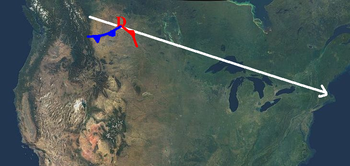- Alberta clipper
-
An Alberta clipper (also known as a Canadian Clipper) is a fast moving low pressure area which generally affects the central provinces of Canada and parts of the Upper Midwest and Great Lakes regions of the United States.[1] Most clippers occur between December and February, but can also occur occasionally in the month of November. Alberta clippers take their name from Alberta, Canada, the province from which they appear to descend, and from clipper ships of the 19th century, one of the fastest ships of that time.[2]
Contents
Formation
A clipper originates when warm, moist winds from the Pacific Ocean come into contact with the mountains in the provinces of British Columbia and then Alberta.[1][3] The air travels down the lee side of the mountains, often forming a chinook in Alberta, then develops into a storm over the Canadian prairies when it becomes entangled with the cold air mass that normally occupies the region in winter. The storm then slides southward and gets caught up in the jet stream, sending the storm barreling into central and eastern areas of North America.[4]
Ironically, the chinook which in part originates the Alberta clipper usually brings relatively warm weather (often approaching 10C/50F in the depths of winter) to southern Alberta itself, and the term is therefore not used in Alberta.
Effects
The storms sweep in at high speed over whatever land they encounter, usually bringing with them sharp cold fronts and drastically lower temperatures. It is not uncommon for an Alberta clipper to cause temperatures to drop by 16°C (30°F) in as little as 10 to 12 hours. Often, the storms bring biting winds with them, only increasing the effect of the newly lower temperatures. Winds in advance of and during an Alberta clipper are frequently as high as 56 to 72 km/h (35 to 45 mph). These conditions would cause wind chill values to drop into the -30 to -45 Celsius (-20 to -50 Fahrenheit) range[4].
Snowfall amounts with these systems tend to be small (on the order of 1 to 3 inches or 2.5 to 7.5 cm), as the severe lack of moisture and quick movement inhibit substantial snowfall totals. However, several factors could combine to produce somewhat impressive snowfall totals (6 inches/15 cm or more). These factors include access to more moisture (which raises precipitation amounts), slower system movement (which increases snowfall duration), and colder temperatures (which increases the snow to water ratio). The southern and eastern shores of the Great Lakes often receive enhanced snowfall from Alberta clippers during the winter, due to lake enhancement. The lake-effect snow can add substantially to the overall snowfall total[4].
Occasionally the clippers, when reaching the Atlantic seaboard (usually between the Virginia and New England coasts), 'bomb out' and can cause severe winter weather along the coast as Atlantic moisture is tapped. Snowfall amounts can approach 6"-12" or more when this happens.
During the winter, Alberta clippers can occur somewhat frequently, with system intervals on the order of two to four days common during active periods.
Variations
Two variations of Alberta clippers are Manitoba mauler or Saskatchewan screamer.[5][6] These two types of systems are far less common than clippers, and even when they take place they are still often referred to as clippers. The main difference among the three is from which Canadian province they begin their southward trek.[7]
In popular culture
In the mid-1990s, Former Minnesota Vikings head coach Dennis Green erroneously referred to an Alberta Clipper as a "Calcutta Clipper" when talking about weather patterns that would have affected his teams preparation for an upcoming game[citation needed].
See also
- Snowsquall
- Ground blizzard
- Windchill
- North American weather patterns
References
- ^ a b Dave Thurlow. "Alberta Clipper". The Weather Notebook. http://www.weathernotebook.org/transcripts/2000/02/15.html. Retrieved 2007-04-16.
- ^ Douglas, Paul (2004). Restless Skies. Barnes & Noble Publishing, Inc.. p. 50. ISBN 0-7607-6133-2.
- ^ Keith Heidorn. "Alberta Clipper". The Weather Notebook. http://www.weathernotebook.org/transcripts/2003/03/31.php. Retrieved 2007-04-16.
- ^ a b c "Nor'easters and Alberta Clippers". The Weather Doctor. http://islandnet.com/~see/weather/storm/neaster.htm. Retrieved 2007-04-16.
- ^ "Glossary: Alberta Clipper". NOAA. http://www.crh.noaa.gov/glossary.php?word=ALBERTA%20CLIPPER. Retrieved 2007-05-10.
- ^ John Gordon. "A COMPREHENSIVE WINTER WEATHER FORECAST CHECKLIST". NWS - Springfield, Missouri. http://www.crh.noaa.gov/sgf/?n=winter_checklist_paper. Retrieved 2007-05-10.
- ^ Swanson, Bob (December 5, 2007). "Snowstorms or wrestling names?". USA Today. http://blogs.usatoday.com/weather/2007/12/snowstorms-or-w.html. Retrieved 2008-05-07.
Further reading
- Williams, Jack: The Weather Book, 1997, Vintage Books, ISBN 0-679-77665-6.
- Dunlop, Storm: The Weather Identification Handbook: The Ultimate Guide for Weather Watchers, 2003, The Lyons Press, ISBN 1585748579.
External links
- Extratropical Lows: Clippers Meteorology Department of the University of Illinois
Categories:- Extratropical cyclones
- Blizzards in the United States
- Natural history of Alberta
- Natural history of Saskatchewan
Wikimedia Foundation. 2010.

